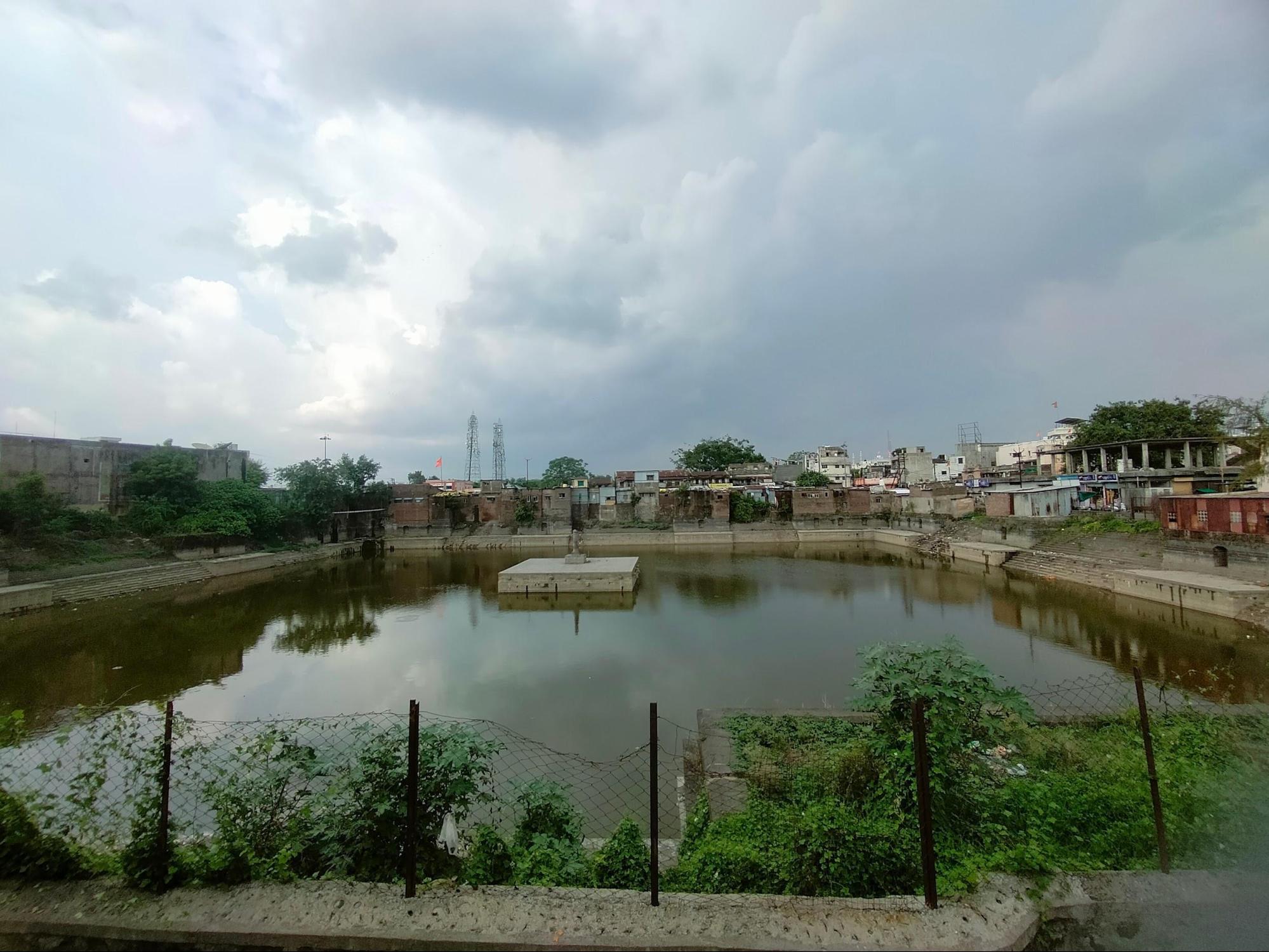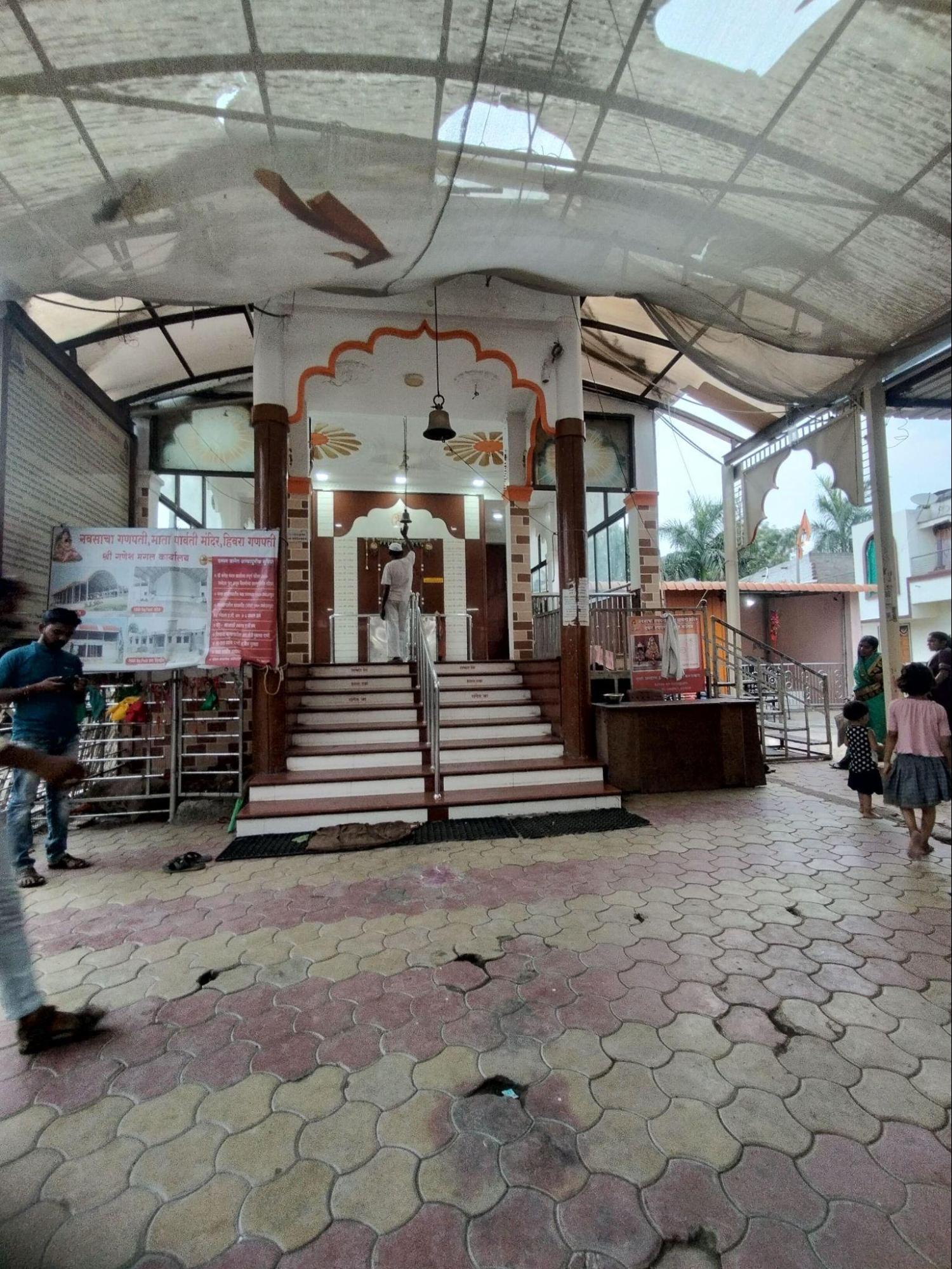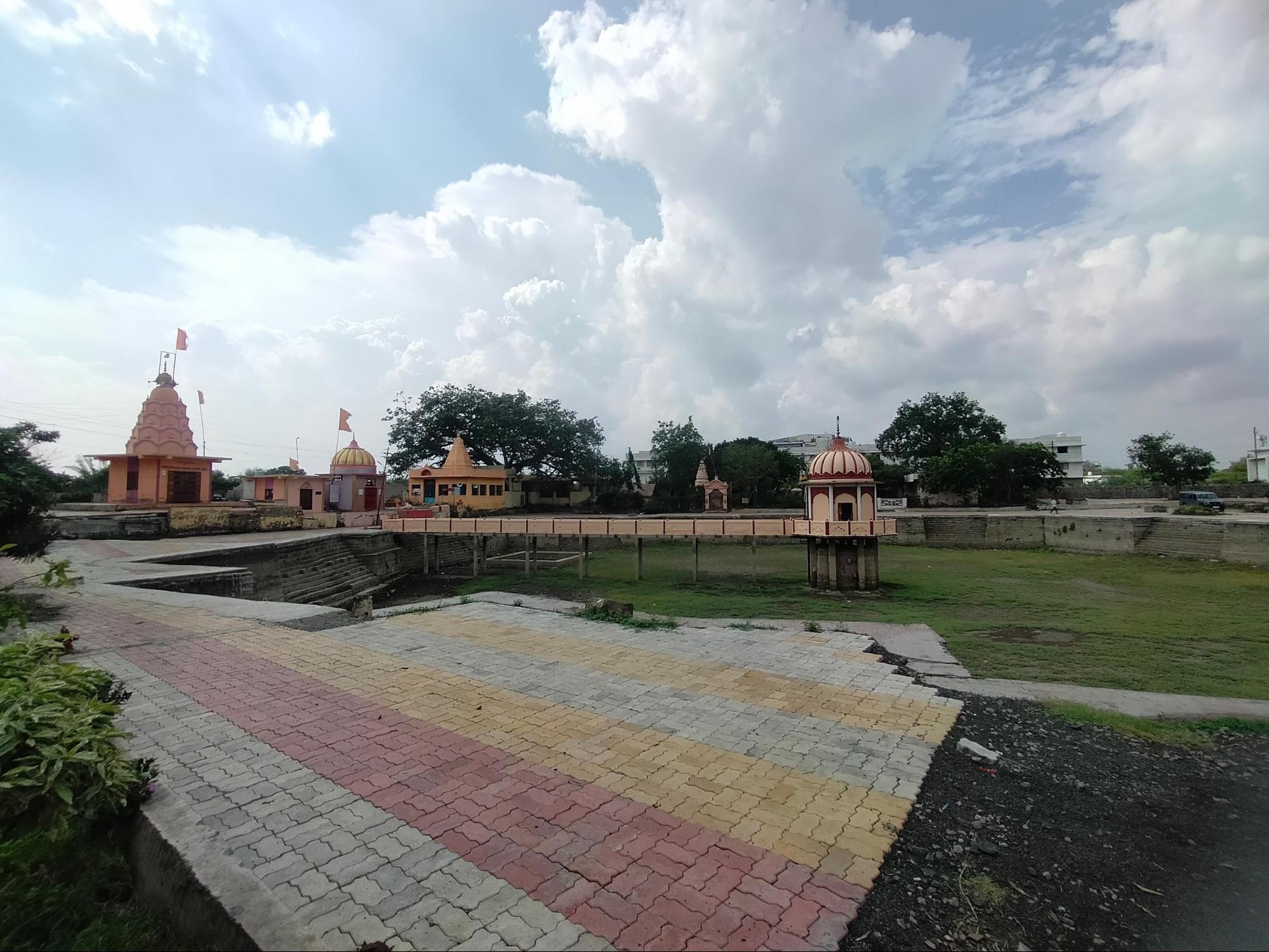WASHIM
Cultural Sites
Last updated on 22 July 2025. Help us improve the information on this page by clicking on suggest edits or writing to us.
Daridraya Haran Talav
Daridraya Haran Talav, also known as Phutke Lake or Narayan Baba Talav, is a tirtha located near the Narayan Baba Datta Mandir in Washim. Notably, the name of the site literally means “the lake that alleviates poverty,” and refers to the practice of immersion and prayer offered as part of vows for relief.
The lake is associated with several significant figures and legendary events. It is mentioned in the Akola District Gazetteer (1977) that many believe it was created long ago by Dattatreya, a yogi and Devta believed to be a combined form of Brahma, Vishnu, and Shiv.
Interestingly, there is also a belief tied to the site that connects it to a significant episode from the Ramayan. According to this, King Dashratha of Ayodhya, Bhagwan Ram’s father accidently killed Shravan Kumar while sitting on a banyan tree that once stood near the site.
Dev Talav (Chandratirtha)
Dev Talav, also known as Chandratirtha, is a historic sacred tank located in Washim town, adjacent to Shri Balaji Mandir. It was constructed in 1777 CE alongside the creation of the Pushkarani pond, as part of the larger Mandir complex commissioned by Bhavani Kalu.

The lake reaches a depth of 40 ft. and is divided into four levels, each 10 ft. deep. Built with polished stone, the structure is noted for its symmetrical design and elegant construction. For over three decades, Dev Talav has remained filled, although it temporarily dried during the severe drought of 1972. The lake, today, is usually used for the immersion of murtis during festivals such as Ganesh Chaturthi, Durga Visarjan, and Chaitra Gauri.
Jama Masjid
Jama Masjid in Washim is among the largest mosques in the district and is believed to have been constructed during the reign of Adil Shah, Deccan Sultanate ruler.
Narayan Baba Datta Mandir
Narayan Baba Datta Mandir is located in Washim, near Daridraya Haran Talav. The Mandir is dedicated to Sant Narayan Baba, also known locally as Telangi Baba or Khatke Baba. He lived between 1909 and 1949, and after years of traveling in the region, he settled in Washim, where he became widely revered.
![Entrance of Narayan Baba Datta Mandir, a revered spiritual site in Washim, dedicated to Sant Narayan Baba.[1]](/media/culture/images/maharashtra/washim/cultural-sites/entrance-of-narayan-baba-datta-mandir-a_oqG0tvM.png)
The two-storey Mandir houses a 4 ft. marble murti of Narayan Baba in the garbhagriha (sanctum). Adjacent to the garbhagriha are personal belongings of Narayan Baba, including his mattress and footstool. The Mandir is maintained by a team of dedicated bhakts and serves as a site of local religious activity.
Navsacha Ganpati Mata Parvati Mandir
Navsacha Ganpati Mata Parvati Mandir is located in Hiwara village. The Mandir, estimated to be over 100 years old, is dedicated to Shri Ganesh and Mata Parvati, and is visited by people from Vidarbha, Marathwada, and other parts of India.

The site is known as a jagrut tirtha (active pilgrimage site). Local tradition tells of a Pardhi couple whose sick child was healed after they applied sacred embers from the Mandir, leading to its spiritual significance. Many couples visit the Mandir seeking children and return annually for five years, especially during Ganesh Chaturthi.
Annual events include Ganeshotsav, Sankat Chaturthi, and Ganesh Jayanti. The Mandir is being expanded with a meeting hall, rest house, and other facilities funded by bhakts.
Padmatirtha
Padmatirtha is a sacred lake and Mandir complex located in Deopeth. The site is considered to be of considerable antiquity. Notably, the Akola district Gazetteer (1977) mentions that its origins can be traced back to a time when 108 tirthas (sacred springs or holy sites) were believed to exist in Washim. Among these, Padmatirtha is described as “one of the chief tirthas created by Vishnu.”

Interestingly, it is said that each tirtha was linked to a Rishi. Padmatirtha, in local tradition, is tied to Sant Dadhichi, who is regarded as the author of the Atharvaveda. He is remembered for offering his bones so the Devtas could create Vajra, the divine weapon used to defeat the Rakshas Vritra. It is believed that his bones were immersed in the waters of Padmatirtha.
The etymology of the site is, notably, rooted in this very legend, which tells of Bhagwan Vishnu, who, while searching for Garuda (his eagle mount), placed a lotus on the ground at Washim. The lotus is believed to have created the Padmatirtha reservoir, giving the site its name (padma meaning lotus). Vishnu is also said to have consecrated the nearby Padmeswara Linga and left behind weapons formed from the ashes of Sant Dadhichi before ascending to Swarg (Heaven).
Padmatirtha has also been linked to historical figures. Among them is Ramdevrao Yadav, the 12th-century ruler of Devagiri, who is said to have bathed at the site. At the time, it is believed that the reservoir featured ten stone-paved ghats, where bathing rituals, echoing those of the Ganga, were performed. Immersion in its waters was regarded as purifying, with some traditions holding that even cremated remains would dissolve entirely into the lake. Many practitioners, drawn by these enduring associations, continue to visit Padmatirtha for ritual bathing and darshan.
Pir Gaibi Masjid, Markaz
Pir Gaibi Masjid, also known as Tonggaon Masjid, is located in Tondgaon. The Masjid features the shrine of Jagirdar Pir Gaibi, a revered Sufi saint. The Masjid also houses a madrasah and underwent renovation in 2002. It has been a place of religious importance for centuries.
Poharadevi
Poharadevi, in Washim district, is a major yatra site for the Banjara community. It is home to the samadhi of Sevalal Maharaj (also known as Sevabhaya), an 18th-century social reformer and spiritual leader who is widely venerated by Banjaras. The site also includes several mandirs dedicated to Mata Jagdamba, who is widely worshipped within the community.
![Jagdamba Devi Mandir, Poharadevi Village, Washim, which is significant to the Banjara community.[2]](/media/culture/images/maharashtra/washim/cultural-sites/jagdamba-devi-mandir-poharadevi-village_ngGe4nd.png)
Three yatras are held at Poharadevi each year; during Diwali, fifteen days after Diwali, and on Ramnavami in March or April, observed as the birth anniversary of Sevalal Maharaj. These events draw large numbers of Banjara pilgrims from Maharashtra, Karnataka, Andhra Pradesh, and other regions.
Shri Antariksh Parshwanath Mandir, Shirpur
Shri Antariksh Parshwanath Mandir, also known as Basti Mandir, is located in the center of Shirpur village and is believed to have been constructed in 1142 CE. The Mandir is significant to both the Digambara and Shwetambara sects of Jainism and serves as a major yatra site, especially during Kartik Poornima (a festival observed around November).
![Shri Antariksh Parshwanath Mandir in Shirpur village, Washim, is significant to the Digambara and Shwetambara sects of Jainism.[3]](/media/culture/images/maharashtra/washim/cultural-sites/shri-antariksh-parshwanath-mandir-in-sh_CDc85DA.png)
The creation of the Shri Antariksh Parshwanath Mandir is steeped in legend and tied to a miraculous event. The story begins with the murti of Parshwanath (23rd Tirthankara in Jainism), whose history stretches far beyond the Mandir itself. It is said that this murti was originally crafted by King Khara, a legendary figure who is mentioned in the Ramayan.
For many years, the murti remained lost, submerged in a well near Ellora. Its rediscovery came about when King Shripal of Achalpur, stricken with a severe illness, was healed after drinking water from the well. Guided by divine instructions, the king brought the murti to Shirpur, where it is said to have floated mid-air, marking the exact spot where the Mandir was to be built.
Shri Balaji Mandir
Shri Balaji Mandir, located in Washim town, is a historic Mandir dedicated to Bhagwan Vishnu (Balaji). It was constructed in the 18th century under the patronage of Bhavani Kalu, who served as Diwan (chief administrator) to Sabaji and Janoji Bhosle, rulers of the Nagpur-based Bhosle dynasty of the Maratha Empire.

The establishment of the Mandir has an interesting history. Around 1760 CE, a horseman is said to have accidentally discovered part of a buried murti. This led to the recovery of several murtis, including those of Brahma, Vishnu (Balaji), Mahadev, Devi Parvati, Shri Ganpati, and Naga. In response to this discovery, Bhavani Kalu initiated the construction of the Mandir, which took 12 years to complete. During this period, a significant water tank, known as Dev Talav or Balaji Talav, was also constructed nearby.
Shri Karuneshwar Mandir
Shri Karuneshwar Mandir is an ancient Shiv Mandir located in Shukrawar Peth, Washim and is regarded as the kuldevta Mandir by many local families. Its significance is closely tied to the Karuna River, which flows through the town and to a time when Washim was known as a sacred kshetra. It is mentioned in the Akola district Gazetteer (1977), that during this time, it is believed that many Rishis and Devis and Devtas inhabited the site across a five-kos radius.
![Shri Karuneshwar Mandir and Shri Ganesh Mandir, nestled side by side in Shukrawar Peth, Washim.[4]](/media/culture/images/maharashtra/washim/cultural-sites/shri-karuneshwar-mandir-and-shri-ganesh_WcXfSIt.png)
Among these Rishis was Vatsarishi who is said to have performed penance at the site with such intensity that it disrupted the natural order. Rivers dried up, trees withered, and even the Devis and Devtas grew unsettled. While they gathered nearby, it was Bhagwan Shiv who appeared before the Rishi. Moved by his devotion, Shiv wept, and his tears are believed to have filled a dry well, giving rise to the Karuna River. When Vatsarishi asked that he remain at the site to bless those who came in faith, Shiv agreed and stayed in the form of Karuneshwar.
Today, the Mandir complex remains a place of significant religious activity, hosting major festivals like Mahashivratri and Vaikunth Chaturdashi. It also includes an ancient Shri Ganesh Mandir and a hall for various religious gatherings.
Shri Ram Mandir Sansthan
Shri Ram Mandir is a historic Mandir in Washim town, located opposite Dev Talav. It is said that the Mandir was established approximately 250 years ago by Bhagvandas Maharaj Bairagi, a respected religious figure of the region.

A two-storey dharamshala has been recently constructed in front of the Mandir. It serves as a residence for visiting bairagis and is also utilized for weddings and other religious functions. Notably, the festival of Ram Navami is celebrated annually at the Mandir with great public participation.
Sources
History of WA. 2014. Washim City. Blogspot.https://historyofwa.blogspot.com/2014/03/nor…
Maharashtra State Gazetteers. 1977. Akola District. Gazetteers Department, Government of Maharshtra, Bombay.
Maharashtra Tourism. Shri Antariksh Parshwanath Mandir, Shirpur. Maharashtra Tourism..https://maharashtratourism.gov.in/temple/shi…
Last updated on 22 July 2025. Help us improve the information on this page by clicking on suggest edits or writing to us.